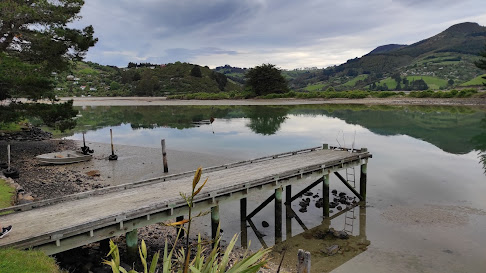Today was a longer walk as I combined finishing the streets in Port Chalmers with walking the streets in Careys Bay. I walked 22 streets today
1561. Bernicia Street
1562. Bellevue Place
1563. Fox Street
1564. Meridan Street
1565. Harrington Street
1566. Laing Street
1567. Burns Street
1568. Daly Street
1569. Mount Street
1570. Church Street
1571. Ajax Road
1572. Borlases Street
1573. Blueskin Road
1574. Kohi Place
1575. William Street
1576. Coombe Hay Terrace
1577. Harbour Terrace
1578. Cemetery Road
1579. Willmott Street
1580. Slant Street
1581. Henry Street
1582. Macandrew Road
My walk today took me over the top of the hill at Port Chalmers, although I did have to walk up and down the hill a couple of times as I walked each street completely.
The houses on the streets that I was walking today were positioned on the hill so that they looked either towards the harbour or towards Mt Cargill. Today the harbour was calm with great reflections of harbour cone.
Mt. Cargill has dominated the view in many parts of the city that I have walked although I haven't seen it from this angle before. Mt. Cargill has the transmitter on it with Buttars Peak beside it and Mt Holmes further along.
Port Otago is obvious from most streets in Port Chalmers. I have been able to see the crane gantries and ships or hear the noises from the port during my walk of the streets.
Having seen the Iona Church from most parts of Port Chalmers, this is as close as I got to walking past it. Built from Port Chalmers Blue Stone and Oamaru Stone, Iona Church was built in 1872 and is still used for services today.
After walking past Iona Church, I continued walking up the hill behind Port Chalmers. This was a great place to be able to see the streets that I have been walking. It is always a good feeling looking back and knowing that I have walked every street that I can see.
As I walked further up the hill, I crossed the railway line. I have been around this railway line many times during my challenge to walk every street. From here I had beautiful views looking down the harbour towards the city and closer are the houses of Roseneath.
Eventually I walked all the way to the Robert Scott Memorial Lookout. The views from the look out are fantastic and I was able to see most of Port Chalmers, both Goat and Quarantine Island in the middle of the harbour and harbour cone on the peninsula behind.
I was also able to look down onto the port with two container ships. It was fascinating to watch the gantries and straddle carriers moving about, lifting and loading containers. From this height everything looks small, however I remember how big and high the rows of containers were when I was walking down near them.
Built in 1913, the Scott Memorial commemorates the ill-fated Scott expedition that left Port Chalmers for Antarctica on 19 November 1910
Also at the site of the Scott Memorial is this large iron anchor from an unknown sailing ship that often got caught in local fisher nets, it was hauled ashore in 1978.
From the lookout, I took a track past the Port Chalmers cemetery to Careys Bay which is the next bay around from Port Chalmers. The streets of Careys Bay are steep and the houses are nestled amongst native bush.
Most of the houses in Careys Bay have a view of the marina and habour. Today the habour was calm with no wind and it was a beautiful place to be walking.
Careys Bay is also close to Port Otago. It was easy to see from this angle how much the port dominates the area with the containers stacked high.
Once down from walking the streets on the hill, it was nice to be beside the sea and watch the boats bobbing on the harbour while I walked back along the road around the bottom of the hill.
One of the lovely old buildings I walked past today is the Chick's Hotel
beside Port Otago. Built in 1876, Chicks operated as a hotel and more
recently a music venue until it closed in 2016.
The Careys Bay Hotel was another historic hotel that I walked past today. Built in 1874 from Port Chalmers Blue Stone, the hotel has been continuously serving alcohol and today is a popular seafood restaurant particularly during weekends.
Another historic building that I walked past was the old Port Chalmers School. There has been a school at Port Chalmers since 1856 on various sites. This school building has been turned into a home.
I walked past the memorial to where the local Ngāi Tahu sold the Otago block to the New Zealand Company in 1844.
I have often driven past this large tree that has grown beside the road. The footpath goes around the tree and it is obviously a notable tree but there was no plaque or sign to say why.
The bus stop at Port Chalmers is painted to match the suburb with a boat, the harbour and Mt. Cargill as the main features.
I walked past three interesting letterboxes today. The house shaped letterbox was similar in shape to the house that it belonged to and the castle letterbox looked nothing like the house that it belonged to. I thought the anchor letterbox was very appropriate for the home it belonged to - near the sea.
And finally, below is the map of the streets that I have walked in Port Chalmers and Careys Bay as well as Sawyers Bay and Roseneath.
Distance walked: 10.9 km
Walking time 2 hr 3 mins
Total distance: 960.5 km Total walking 179 hr 11 mins












































































